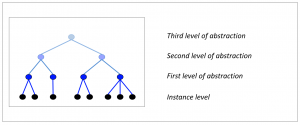A useful concept for understanding hierarchical categorisation systems is levels of abstraction. This is closely linked to the concept of emergent properties, which occur when a level has properties that arise from interactions between the entities in the level(s) beneath it.
At the bottom level of the hierarchy is level 1, also known as the instance level or instantiation level – or, using the ‘inverted tree’ model, leaf level. Above this is level 2 (twig level), and above that is level 3 (branch level) etc. (Note: The levels could also be numbered from top to bottom.)
For example, a collection of individual animals (at level 1) might be grouped into cats and dogs (at level 2) and then into pets (at level 3).
All the levels that are higher than leaf level are human abstractions; only the items at leaf level have a physical existence. For example, the concept of pets is an abstract human invention, whereas an individual pet is a physical animal which exists independently of human categorisation systems.
Levels of abstraction
